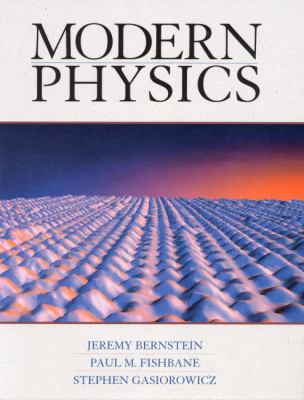124540
9780139553110
Modern Physics
by Bernstein, Jeremy, Fishbane, Paul M., Gasiorowicz, Stephen G.
About this item
- Condition: Good
- Provider: Ergodebooks Contact
- Provider Rating: 82%
- Ships From: Multiple Locations
- Shipping: Standard
- Comments: Buy with confidence. Excellent Customer Service & Return policy.

Product details
- ISBN-13: 9780139553110
- ISBN: 0139553118
- Publication Date: 2000
- Publisher: Addison-Wesley
AUTHOR
SUMMARY
Preface Knowledge of the revolutions of 20th-century physics is an indispensable part of the training of any engineer and physical scientist. That is because virtually all of today's technology is based, at least in part, on this knowledge. The basic subject material of what is called modern physics is very nearly 100 years old, so that it is hardly modern at all. Yet just as Newton's laws, today 300 years old, Maxwell's equations, today nearly 150 years old, and the laws of classical statistical physics, more than 100 years old, remain applicable and essential in their respective domains of physical law, so too do the two major developments of the first half of this century: relativity and quantum mechanics. These fundamental subjects underlie a vast scope of application that continues its inventive course today. Moreover, research on fundamental physics has not stopped with relativity and quantum mechanics, and working scientists still face questions as interesting as any that have been answered in the past. Both relativity and quantum mechanics require the student to make difficult changes in how he or she thinks the physical world works. The subjects violate prejudices that have been built up by everyday experience. For this reason, precision and clarity of explanation are, for us, the first and most important part of the material. We have made every effort to avoid the "it can be shown" approach and to present modern physics in a way that makes its interconnectedness, as well as its connection to classical physics, evident. Throughout this text, we have built in a historical approach - a discussion of how a subject developed and the thinking that led to its maturation. Often this historical perspective is interwoven with the material; at other times it would interrupt an efficient and compact presentation, and then we present it on the side, as it were. We feel that this approach is useful in that it stresses that the roots of the revolutionary advances lie in experiment; it also makes the text more fun to read. The book forms the basis of a traditional course in the subject. It contains, in a mathematical language that we have deliberately kept at a level we felt students would be comfortable with, descriptions of special relativity and of the laws of quantum mechanics. It describes applications of these fundamental ideas to both technological and scientific issues. Finally, it describes the subject matter that is of fundamental interest today. All this material is too much to cover in one semester, the usual length of time for such courses, so a more detailed explanation of what we do is in order. This will allow the instructor to make a reasonable choice of what to cover and provide guidance to the reader or the use of the material in the book. We have broken the material into several parts, even if the boundary between the coverage of the different parts is not always perfectly sharp. The first chapter replaces what would otherwise be a steady set of footnotes referring the reader to an introductory calculus-based textbook. In other words, Chapter 1 is a place to remind students of things that, ideally, they should have fully absorbed in their introductory courses. While the chapter cannot replace such a textbook, it can be a convenient road map to the introductory material. It also constitutes a type of formulary of classical physics. But we urge the student to keep his or her introductory text and to consult it when necessary. The chapter contains no examples or problems, and it is not meant to be assigned as normal course material. Part 1 consists of two chapters on special relativity. These are divided more or less according to traditional lines, with a discussion of space and time in one chapter and momentum and energy in the next. Our approach is to extract length contraction from the Michelson-Morley result and use it as a jumping off point for the other effects ofBernstein, Jeremy is the author of 'Modern Physics', published 2000 under ISBN 9780139553110 and ISBN 0139553118.
[read more]


